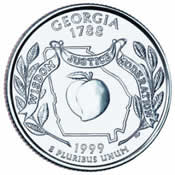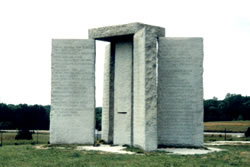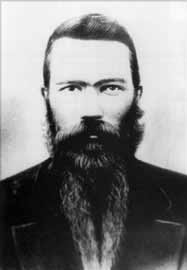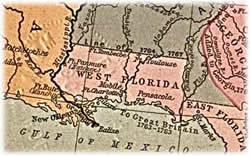- Details
- Written by: G.S. Strange
- Category: Archive
- Hits: 1544
A small area of the southern United States bordered by the Mississippi River on the west, the Perdido River on the east, the 31st parallel on the north, and a line from the northern banks of Lake Pontchartrain across to the Gulf of Mexico was known as the Republic of West Florida for a whopping 90 days.
In June of 1810, representatives from the sixteen counties that would become the Republic of West Florida began to meet to discuss their displeasure with the Spanish government’s management of the region. During these meetings, Melissa Johnson, wife of Major Isaac Johnson who commanded the West Florida Dragoons, was elected to create a flag that would properly represent the delegates’ feelings. Because the region was neither a part of the United States nor French Louisiana, and the citizens of the region no longer wanted to be a part of Spanish territory, she decided on a single white star in a field of blue, to represent the desire to stand alone. The flag of the Republic of West Florida would come to be known as the Bonnie Blue Flag and would be used by the Republic of Texas in that territory’s struggle against Spain and later as the unofficial Flag of the Confederacy during the Civil War.
On September 23, 1810, militia forces of West Florida overran the Spanish fort at Baton Rouge, LA. They raised the flag of the Republic of West Florida and declared their independence from Spain. Representatives met at St. Francisville, the capitol, and created the Constitution of West Florida. They elected legislators and a governor, Fulwar Skipwith. However the life of the Republic would be a short one. One month after the attack on Baton Rouge, President James Madison announced that the newly formed Republic was actually part of the Louisiana Purchase and the region would be annexed into the United States. Initially, Governor Skipwith and the West Florida government were conflicted with the annexation but would eventually realize the economic value in becoming a part of the U.S. In December of 1810, St. Francisville was turned over to the federal government and the Republic of West Florida would fade into history.
- Details
- Written by: G.S. Strange
- Category: Archive
- Hits: 1523
“The Stars and Stripes waved in a gentle breeze today above Dade County Courthouse, last citadel of the Confederacy.”
~Chattanooga Free Press, July 4, 1945
 The story of the Independent State of Dade is, without question, a murky one. Some say that the event never actually happened, while others contend that Dade County was indeed an independent nation for 85 years. You decide.
The story of the Independent State of Dade is, without question, a murky one. Some say that the event never actually happened, while others contend that Dade County was indeed an independent nation for 85 years. You decide.
In 1860, the Representative from Dade County, Georgia, Bob Tatum, gave a fiery speech on the floor of the state Capital in which he stated, “By the gods, gentlemen, if Georgia does not vote to secede immediately from the Union, Dade county will secede from the state and become the independent state of Dade.” When Georgia failed to pass a resolution to secede from the Union, Tatum returned to Dade County where, in a public meeting, the citizens of Dade decided to secede from the Union and the state of Georgia. Tatum sent secession proclamations to both the state and to Washington, D.C. and although neither Georgia nor the federal government recognized or even took the proclamations seriously, the citizens of Dade County took their independence seriously.
Dade County’s geographical position in the state added to the confusion of the region’s independence. At the time that Tatum made his proclamations in 1860, Dade County was very isolated. There were no roads that lead to the county from Georgia. To get to the county seat of Trenton, travelers had to leave Georgia into Tennessee then reenter Dade from the north; or leave the state into Alabama and reenter from the south. It would not be until 1940-41, when Highway 136 was constructed, that Dade County was officially connected to the rest of the state. Five years later (July 4th, 1945) the county fathers of the Independent State of Dade declared that they were readmitting themselves into the Union. The event was widely covered in local, state and national newspapers. “Dade County Ends ‘Secession’” was the headline in the New York Times. President Harry Truman dispatched a telegram of congratulations from Washington to the citizens of Dade County which ended with “Welcome home, pilgrims.”
It must be noted here that the U.S. Mint, in its 1999 creation and printing of the Georgia state quarter left the far northwest corner of the state off of the coin. It left out the Independent State of Dade. You decide!
- Details
- Written by: G.S. Strange
- Category: Archive
- Hits: 1527

Joshua Norton (AKA Emperor Norton)
In the history of San Francisco no character has ever stood out more than Joshua Norton. He was born in England and spent most of his life in South Africa. In 1849 he received a large inheritance and sailed for San Francisco with a dream of supplying Peruvian rice to the California Territory. In the years that followed, Norton’s rice venture failed and an unsuccessful lawsuit drove Joshua out of San Francisco and out of his mind. He returned a year later and he had clearly gone insane from the strain of the loss of his business and his holdings.
In 1859, Joshua Norton sent a declaration to several California newspapers which read: “At the peremptory request and desire of a large majority of the citizens of these United States, I, Joshua Norton, formerly of Algoa Bay, Cape of Good Hope, and now for the last 9 years and 10 months past of San Francisco, Cal., declare and proclaim myself Emperor of these United States……..”
Norton I, Emperor of the United States
Emperor Norton later added to his title, “Protector of Mexico,” and declared that there would no longer be a need for a legislature. He then abolished Congress as well as the Democrat and Republican parties. He established a fictional Treasury and was in the habit of fining people for various “crimes.” The money was to be used for the construction of a bridge from San Francisco to Oakland. No one ever paid his fines, but in a strange twist the San Francisco-Oakland Bay Bridge was completed in 1936 and bears a plaque with his name.
It was widely known in San Francisco the Joshua Norton was mentally ill and penniless. However, Emperor Norton I was well received at restaurants and events around town. Restaurant owners would place brass plaques above the door of their establishment welcoming Emperor Norton. Dressed in a uniform given to him by Army officers from the Presidio and sporting his brass tipped cane, Joshua Norton’s eccentric behavior lasted for twenty-one years with his decrees continuing until he fell dead on California Street in downtown San Francisco on January 8, 1880. He was buried two days later and an estimated 10,000 people attended his funeral.
- Details
- Written by: G.S. Strange
- Category: Archive
- Hits: 1590
 On a small farm in Elbert County, Georgia stands the “American Stonehenge”. The structure is a cluster of six granite stones standing 19 feet, 3 inches tall and weighing 237,000 pounds. This unique and misunderstood monument was erected by the Elberton Granite Finishing Company on March 22, 1980 as a commission paid for by the very mysterious R. C. Christian. The land on which the structure was placed was once the farm of Wayne and Mildred Mullenix, also purchased by Christian.
On a small farm in Elbert County, Georgia stands the “American Stonehenge”. The structure is a cluster of six granite stones standing 19 feet, 3 inches tall and weighing 237,000 pounds. This unique and misunderstood monument was erected by the Elberton Granite Finishing Company on March 22, 1980 as a commission paid for by the very mysterious R. C. Christian. The land on which the structure was placed was once the farm of Wayne and Mildred Mullenix, also purchased by Christian.
It is not known who R.C. Christian was however many theories exist about who he was and his reasons for building the structure. The most common theory states that R.C. Christian was a pseudonym for Christian Rosenkreuz, a 17th century philosopher and founder of the secret society, the Rosicrucian Order. The Rosicrucian Order developed a doctrine which is "built on esoteric truths of the ancient past", and, "concealed from the average man, provide insight into nature, the physical universe and the spiritual realm.”
Another theory is that the stones were built as a guide in the rebuilding of society in the event of a global catastrophe. Case in point, the stones were erected during the height of the cold war. This theory could also be supported by the fact that the structure has natural alignments such as a hole running through it that is in line with the celestial poles and slots that mark the travel of the sun, hence, acting as a compass and a calendar. The inscriptions on the stones are written in eight different languages and they read:
- Maintain humanity under 500,000,000 in perpetual balance with nature.
- Guide reproduction wisely — improving fitness and diversity.
- Unite humanity with a living new language.
- Rule passion — faith — tradition — and all things with tempered reason.
- Protect people and nations with fair laws and just courts.
- Let all nations rule internally resolving external disputes in a world court.
- Avoid petty laws and useless officials.
- Balance personal rights with social duties.
- Prize truth — beauty — love — seeking harmony with the infinite.
- Be not a cancer on the earth — Leave room for nature — Leave room for nature.
- Details
- Written by: G.S. Strange
- Category: Archive
- Hits: 1520
LOWRY is the name of this robber baron of the period, and his stronghold is an island at the centre of an almost inaccessible swamp in Robeson County, North Carolina. There he dwells in state with his retainers, a motley crew of whites and blacks, runaway slaves of the war time, deserted soldiers of both armies, and miscellaneous outlaws…..
~Robin Hood Come Again: New York Times, July 22, 1871

Henry Berry Lowery
The story of Henry B. Lowery began in 1863 when Confederate forces began to round up members of the Tuscarora and Lumbee Indian tribes of southwestern North Carolina and press them into service building Fort Fisher at the mouth of the Cape Fear River. Henry and a small band of his fellow tribesmen refused to go and slipped away into the swamps of Robeson County. Following reports that Henry had killed two men, (apparently associated with the Confederate Army) the local Confederate Home Guard arrested Henry’s father and brother and promptly executed both of them. This action sparked a decade long guerilla war that would have Henry Lowery and the “Lowery Gang” the single most sought after outlaws in America.
The gang, which consisted of runaway slaves, Tuscarora and Lumbee Indians, Union and Confederate deserters and several petty criminals, first targeted families of the Confederate Home Guard, their supporters and financiers. Robbing those that they felt had wronged them or pressed members of the tribe into service, Henry would divide the spoils that were taken during their nightly raids and use them to continue their reign of terror and feed the families of those that had been pressed into service. Following the war, the Lowery Gang fought feverishly against Reconstruction, targeting those that favored white supremacy over the freed blacks and the region’s Indian tribes.
By 1869 Henry Lowery and the Lowery Gang were the most sought after outlaws in America. They had gained more attention, warrants for arrest and had more news articles written about them than the James-Younger gang of Missouri. History and lore reveals that it all came to an end in 1872 when Henry B. Lowery disappeared. It is not known what became of Henry B. Lowery in that year. Some legends tell of Henry escaping to the New Mexico Territory while others say that he was accidentally killed while cleaning his rifle in the North Carolina swamps. The last of the Lowery Gang was captured or killed by 1874 and Henry B Lowery and the Lowery Gang would be much like Henry himself, lost in history.

